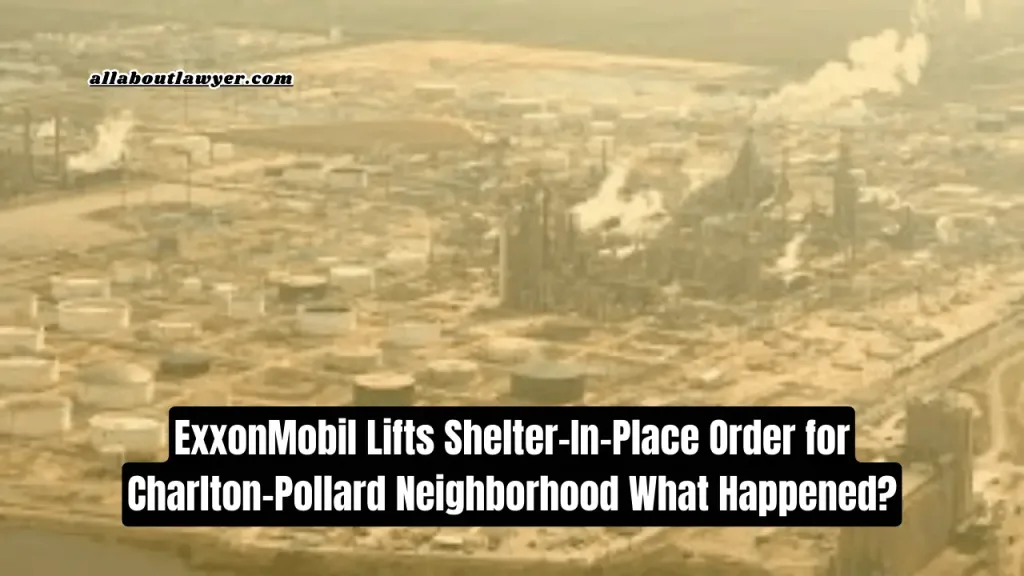ExxonMobil Lifts Shelter-In-Place Order for Charlton-Pollard Neighborhood What Happened?
Beaumont, Texas— On Tuesday afternoon, September 10, 2024, ExxonMobil issued a shelter-in-place order for the Charlton-Pollard neighborhood in Beaumont. This precautionary measure was taken after an operational upset occurred at the refinery’s sulfur processing unit. Just an hour later, ExxonMobil declared the situation under control and lifted the order, reassuring the community that no harmful release of sulfur dioxide had taken place.
The swift actions of the ExxonMobil emergency response team averted a potential disaster, but it left the community with many questions regarding safety procedures, the potential health risks involved, and how future incidents like this might be avoided.
Table of Contents
What Led to the Shelter-in-Place?
ExxonMobil’s Beaumont complex lost one of its sulfur recovery units, which plays a critical role in processing sulfur from finished products like gasoline and diesel. According to Michael Mustian, Complex Manager, when the unit failed, the company issued the shelter-in-place as a proactive measure. “We decided to issue that shelter-in-place out of an abundance of caution,” Mustian said. The company worked diligently to prevent any release of sulfur dioxide into the air, conducting fenceline monitoring throughout the incident.
What Is Sulfur Dioxide, and Why Is It Dangerous?
Sulfur dioxide (SO₂) is a colorless gas with a pungent odor, often compared to the smell of burning matches. It is primarily produced by the burning of fossil fuels and industrial processes. When inhaled, SO₂ can irritate the respiratory system, particularly for individuals with pre-existing health conditions such as asthma or other lung diseases.
Although there was no confirmed release of sulfur dioxide during this incident, the mere possibility of its presence prompted the precautionary shelter-in-place. Had there been exposure, residents could have experienced symptoms such as coughing, shortness of breath, and throat irritation.

How ExxonMobil Responded
Upon realizing the unit failure, ExxonMobil’s emergency response team enacted immediate containment measures. They closely monitored air quality, focusing on sulfur dioxide detection, and assured the public that no hazardous chemicals left the facility. This swift action was key to preventing a larger event from unfolding.
Matt Gully, the Public and Government Affairs Manager for ExxonMobil, emphasized the importance of maintaining transparency throughout the situation. “Our main focus is the safety of our workforce and community,” Gully said. He added that the plant had been working closely with local law enforcement and emergency agencies to manage the situation.
Community Concerns and Reactions
While ExxonMobil’s actions were swift, some community members expressed lingering concerns. Chris Jones, Director of the South End Charlton-Pollard Greater Historical Community Association, reported smelling sulfur even before the shelter-in-place notice was issued. “I smelled sulfur, like a box of matches,” he said, which only added to his worry. Despite the reassurance from ExxonMobil that no leak occurred, this prompted many residents to wonder why they smelled the substance at all.
Jones, and others in the neighborhood, questioned the effectiveness of the measures taken and the accuracy of the air quality assessments. In situations where there is even a slight chance of exposure to hazardous chemicals, the community is left anxious about the safety of their environment.
What Is a Shelter-in-Place?
A shelter-in-place is an emergency procedure that instructs individuals to remain indoors, close all windows and doors, and turn off ventilation systems to prevent exposure to potentially hazardous airborne materials.
When the Charlton-Pollard neighborhood received the order, they were advised to:
- Go inside the nearest building.
- Close and lock all windows and doors.
- Turn off air conditioning and ventilation systems.
- Seal gaps under doors and windows with towels or duct tape.
- Remain indoors until an official “All Clear” is issued.
Such orders are precautionary in nature and aim to protect the public from potential harm, even when the risk is minimal.
ExxonMobil’s BLADE Unit: Reducing Environmental Impact
One silver lining amidst the concern is ExxonMobil’s ongoing efforts to modernize their refinery operations. Their new BLADE unit, scheduled to go online in 2023, is a $2 billion project utilizing the latest heat-integrated technology to reduce emissions. Once operational, it is expected to add an additional 250,000 barrels of crude oil capacity daily, enhancing the plant’s total production to over 600,000 barrels per day.
The BLADE project aims to minimize the environmental footprint of the refinery by reducing harmful emissions, including those from sulfur processing. This is part of a broader strategy to meet increasingly stringent environmental regulations and address community concerns regarding pollution and safety.
The Aftermath: What Happens Next?
After issuing the “All Clear,” ExxonMobil reassured residents that air quality remained safe throughout the incident, with no detection of sulfur dioxide or other hazardous materials. But questions remain about what can be done to ensure an event like this doesn’t happen again—or if it does, how the community can be better prepared.
Mike Mustian, the Beaumont Complex Manager, stressed that ExxonMobil will continue to improve safety measures. “We never want to use our emergency response procedures, but they worked exactly as they should today,” he said. The company plans to continue collaborating with local officials and emergency response teams to improve their response to future incidents.
Conclusion
While ExxonMobil’s swift response successfully contained the issue at hand, the incident serves as a reminder of the potential hazards that come with industrial operations. It also highlights the importance of clear communication and robust emergency procedures.
The community of Charlton-Pollard and the greater Beaumont area now face the challenge of moving forward—reassured by the quick containment but cautious about what future events may hold. ExxonMobil’s investment in advanced technology, like the BLADE unit, aims to reduce the likelihood of such incidents and their environmental impact.
For now, the residents can return to their daily routines, but the smell of sulfur and the memory of the shelter-in-place will likely linger in the air.
Read also:
Body Found in Food Lion Freezer in Raleigh Employee Found Dead in Store Freezer
Did Vladimir Putin Endorse Kamala Harris? Truth Behind Donald Trump’s Claim
FAQs About Exxonmobil Beaumont Texas
What caused the shelter-in-place order in Charlton-Pollard?
The shelter-in-place order was issued due to a potential sulfur dioxide release at ExxonMobil’s Beaumont refinery after an operational upset occurred at one of the sulfur processing units.
Was there a release of sulfur dioxide?
No, ExxonMobil’s air monitoring systems detected no release of sulfur dioxide or any other hazardous chemicals during the incident.
What is sulfur dioxide, and is it dangerous?
Sulfur dioxide is a gas that can irritate the respiratory system when inhaled. It is often produced in industrial processes. Prolonged or high exposure can cause breathing difficulties, especially for individuals with asthma or other respiratory issues.
How did ExxonMobil respond to the situation?
ExxonMobil activated its emergency response procedures, conducting air quality monitoring and working to resolve the issue. The shelter-in-place order was issued as a precaution.
Is the Charlton-Pollard neighborhood safe now?
Yes, after comprehensive monitoring, ExxonMobil and local authorities confirmed that there was no leak, and the air quality was safe. The shelter-in-place order was lifted.
How will ExxonMobil prevent this from happening again?
ExxonMobil is committed to improving its safety procedures and has invested in the BLADE unit, a new project designed to reduce emissions and enhance environmental safety.
About the Author

Sarah Klein, JD, is a licensed attorney and legal content strategist with over 12 years of experience across civil, criminal, family, and regulatory law. At All About Lawyer, she covers a wide range of legal topics — from high-profile lawsuits and courtroom stories to state traffic laws and everyday legal questions — all with a focus on accuracy, clarity, and public understanding.
Her writing blends real legal insight with plain-English explanations, helping readers stay informed and legally aware.
Read more about Sarah
